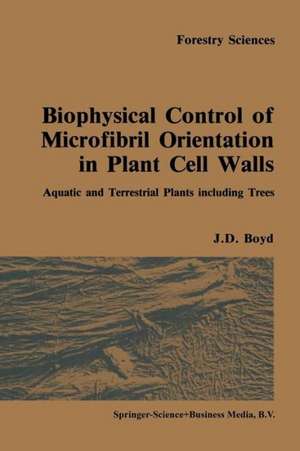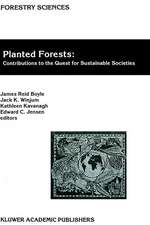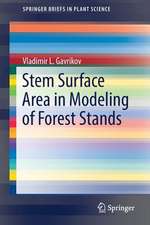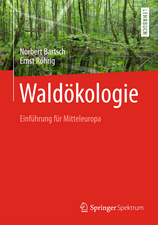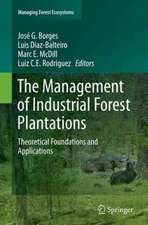Biophysical control of microfibril orientation in plant cell walls: Aquatic and terrestrial plants including trees: Forestry Sciences, cartea 16
Autor J.D. Boyden Limba Engleză Paperback – 23 aug 2014
Din seria Forestry Sciences
- 18%
 Preț: 958.56 lei
Preț: 958.56 lei -
 Preț: 388.13 lei
Preț: 388.13 lei - 15%
 Preț: 644.18 lei
Preț: 644.18 lei - 18%
 Preț: 1848.16 lei
Preț: 1848.16 lei - 18%
 Preț: 2105.44 lei
Preț: 2105.44 lei -
 Preț: 390.25 lei
Preț: 390.25 lei - 18%
 Preț: 950.33 lei
Preț: 950.33 lei -
 Preț: 390.84 lei
Preț: 390.84 lei - 18%
 Preț: 1226.73 lei
Preț: 1226.73 lei - 18%
 Preț: 950.33 lei
Preț: 950.33 lei - 18%
 Preț: 1234.77 lei
Preț: 1234.77 lei - 15%
 Preț: 637.28 lei
Preț: 637.28 lei -
 Preț: 387.58 lei
Preț: 387.58 lei -
 Preț: 385.62 lei
Preț: 385.62 lei - 18%
 Preț: 952.72 lei
Preț: 952.72 lei - 18%
 Preț: 1219.63 lei
Preț: 1219.63 lei - 18%
 Preț: 1229.73 lei
Preț: 1229.73 lei - 15%
 Preț: 647.59 lei
Preț: 647.59 lei - 18%
 Preț: 949.73 lei
Preț: 949.73 lei - 18%
 Preț: 946.10 lei
Preț: 946.10 lei - 18%
 Preț: 2762.55 lei
Preț: 2762.55 lei - 15%
 Preț: 644.95 lei
Preț: 644.95 lei - 18%
 Preț: 1840.26 lei
Preț: 1840.26 lei - 18%
 Preț: 1228.15 lei
Preț: 1228.15 lei - 18%
 Preț: 1236.69 lei
Preț: 1236.69 lei - 15%
 Preț: 639.73 lei
Preț: 639.73 lei - 18%
 Preț: 1847.21 lei
Preț: 1847.21 lei
Preț: 383.50 lei
Nou
Puncte Express: 575
Preț estimativ în valută:
73.38€ • 76.47$ • 60.76£
73.38€ • 76.47$ • 60.76£
Carte tipărită la comandă
Livrare economică 03-17 aprilie
Preluare comenzi: 021 569.72.76
Specificații
ISBN-13: 9789401087421
ISBN-10: 9401087423
Pagini: 216
Ilustrații: X, 200 p. 23 illus.
Dimensiuni: 155 x 235 x 11 mm
Greutate: 0.31 kg
Ediția:Softcover reprint of the original 1st ed. 1985
Editura: SPRINGER NETHERLANDS
Colecția Springer
Seria Forestry Sciences
Locul publicării:Dordrecht, Netherlands
ISBN-10: 9401087423
Pagini: 216
Ilustrații: X, 200 p. 23 illus.
Dimensiuni: 155 x 235 x 11 mm
Greutate: 0.31 kg
Ediția:Softcover reprint of the original 1st ed. 1985
Editura: SPRINGER NETHERLANDS
Colecția Springer
Seria Forestry Sciences
Locul publicării:Dordrecht, Netherlands
Public țintă
ResearchCuprins
I. Introduction.- II. Reassessment of data relating to the multinet theory of microfibril reorientation.- 1. Data obtained by Probine and Preston (1961) and Green and Chapman (1955).- 2. Data obtained by Frei and Preston (1961a, b).- 3. Data obtained by Green (1960a).- 4. Data obtained by Gertel and Green (1977).- 5. Recent observations claimed to support MGH.- III. Significance of biophysics and genetics in primary growth.- 1. Biophysical interaction with microfibril arrangement in the meristematic area.- 2. Genetic influence on orientations of microfibril additions during extension growth.- IV. Reassessment of data on tip growth and conclusions on MGH.- 1. Reorientation of microfibrils during tip growth.- 2. Conclusions on the multinet hypothesis and reorientation possibilities.- V. Wide variety of microfibril arrangements in plant cell walls.- VI. Critical preliminary considerations for a new theory on microfibril orientation.- 1. Fundamental requirements.- 2. Indicators of the importance of physical factors.- 3. Physical interactions between microfibrils and matrix materials.- 4. Effect of bonding of microfibrils and stress direction on cell wall stiffness and orientation of microfibrils.- 5. Stress distribution effects through the cell wall thickness.- 6. Relationship between helical orientation and the direction of cell extension.- VII. Biophysics of orientation of microfibrils in surface growth.- 1. Identification of the fundamental control factors.- 2. Induction of helical orientation in extension growth.- 3. Reduction of initial helical angle with reducing extension rate.- 4. Operation of critical structural controls in tubular cells with one dominant helical orientation of microfibrils.- 5. Biophysical considerations in the optimum use of plant energy.- 6. Orientation interaction with experimental limitation on strain.- 7. Spiral growth induced by the helical orientation of microfibrils.- 8. Effects of extension growth on the variability of orientation within microfibrils.- 9. The nature and significance of axial striations in Nitella internodal cells.- 10. Formation of branches and development of characteristic orientation of microfibrils.- 11. General nature of lamellae development and induced reactions.- 12. Controls for microfibril orientation changes between lamellae.- 13. Biophysical influence in thickening walls of epidermal and collenchyma cells.- 14. Biophysics of corner thickenings in collenchyma cells.- 15. Association of axial rib thickenings and prominent regular pit fields in parenchyma.- VIII. Helicoidal structure and comparable texture variations.- 1. Helicoidal structure.- 2. Herringbone texture.- 3. Problems in classifying texture as helicoidal, or herringbone, or other type.- 4. Classification of textures of particular plant tissues.- 5. Provisional general conclusions on cell wall texture.- IX. Biophysics of cell wall architecture in secondary wall formation.- 1. Preliminary considerations.- 2. Microfibril organization in the S2 wall layer.- 3. Microfibril organization in the S1 wall layer.- 4. Microfibril organization in the S3 wall layer.- 5. Alternating helical directions between S1, S2 and S3.- 6. Absence of an S3 layer in reaction wood and phloem fibres.- X. Biophysical basis for wall layer nomenclature.- XI. General discussion of the significance of biophysics in plant morphology.- XII. Literature cited.- List of appendices.- Appendix I Reorientation possible prior to microfibrils being fractured by overstrain.- Appendix II Possible reorientation of microfibril fragments.- 1. Effect of extension growth on orientation of microfibril fragments.- 2. The effect of spiral growth on reorientation of microfibril fragments.- Appendix III Hypothetical mean orientation of microfibrils resulting from extension growth in accordance with the multinet growth hypothesis.- 1. General assumptions.- 2. Results.- Appendix IV Interpretation of Green’s (1960a) data on passive reorientation of microfibrils.- 1. Assumption of constant proportional crystallinity through the wall thickness.- 2. Green’s extrapolation of curves.- 3. Curve slopes near outside face of wall.- 4. Microfibril orientation indicated by micrograph of polarized light effects..- Appendix V Alternative models for extension of cell walls.- 1. The isotropic cylinder model.- 2. The helical spring model.- 3. Comparison of isotropic cylinder and helical spring models.- Appendix VI Strain stimulation for microfibril orientation in epidermal cells.
